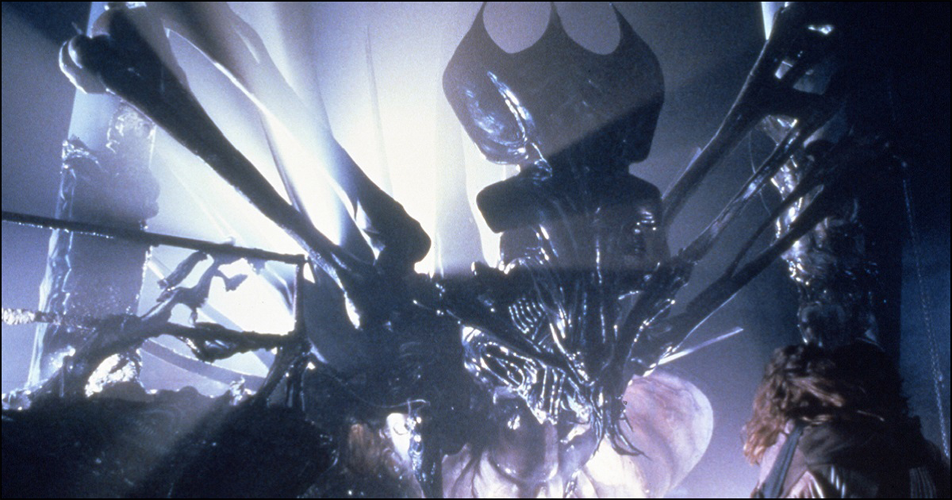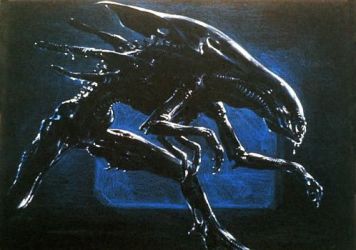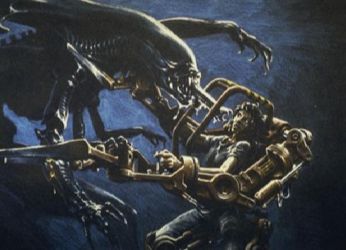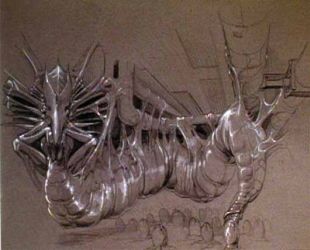


ALIEN
In the earliest concept for the Alien breeding, as conceived by Dan O'bannon, there were three "characters" needed: the egg, the adult Alien, and the host. The alien would produce the egg, place it in front of the sacrificial victim, and the facehugger, sensing the host, would then commit the rape and plant the embryo inside the host's body. A lot of the alien was influenced by insects (or, according to Ridley Scott in The Alien Saga Documentary and The Making of Alien, the alien actually is an ant-like biomechanoid insect), and the breeding process was no different.
Ridley Scott (Director): What gave us the cocoon concept was that insects utilize others’ bodies to be the hosts of their eggs.
Once the story got more developed, rewritten, re-conceptualized and became the classic that the world is familiar with, the concept was slightly changed. While the theatrical cut never explains where do the eggs come from, a scene revealing the source of the eggs was scripted, shot and eventually released in the Director's Cut in 2003. The concept settled on was that the adult alien itself would produce the egg directly out of the host, in simple terms - turn the host into an egg.
Scott: That’s how the Alien would use Dallas and each of the crew members it kills. This explains why the Alien doesn’t kill everybody at once, but rather kills them off one by one: it wants to use each person as a separate host each time it has new eggs
Like insects, the alien would create a spider-like nest and cocoon where it would keep his hosts for breeding. The idea was slightly changed and the cocoon strayed away visually from the spider lair and became a nest built out of enzymes and secreted resin which held the victim's glued and immobilized. The spidery nest still made it into the novelization, but even thought the visual concept was that of an insectal or arachnid cocoon, the eggmorphing was already present. By admission of its creators, the overall Alien story was a B movie story with an A budget, and the egg morphing idea was no different. The idea of a human being turned into something through the monster's enzymes/fluids was presented few times in B movies before and after Alien, in such flicks like 1956's The Creeping Unknown, also known as Quatermass Experiment.
The egg morphing was a carry over from O'Bannon's early script 'They Bite', where the antagonists (ancient insect creatures) burrow out of the Earth and use human bodies as hosts to be transformed (via what O'Bannon described as a digestive/cocooning process) into their half-human, half-insect offspring. When O'Bannon couldn't get 'They Bite' made, he put those same ideas into Alien.
The original Alien nest concept (left), the egg morphing set (middle) and the frame from the movie (left)



The scene was eventually cut for pacing, and some of the creators of the movie seemed not to happy overall with the scene and/or the idea itself
David
Giler (uncredited co-writer, producer): 'That sequence was taken out before
the film was shown anywhere. So no one except us has seen the cocoon footage. It
was removed because it simply didn't work. It interfered with the pacing of the
film. It looked terrible, awful. So instead of redoing it, we decided to write
it off as a bad idea.'
Ron Shusset (co-writer of the story): "When we took out that scene,
the whole thing worked great, and nobody missed it.. The only reason we later
put it in was we had the luxury twenty-five years later, and everybody knew and
were fans of the movie by then, so we could do it. But it’s good we all came to
the same conclusion, because we could have made a terrible mistake: ‘Oh, look at
that great idea we had, where he says, “Kill me!” and he’s growing the egg!"
H.R.Giger (Design): It didn’t really fit with the rest of the film. It used a strange yellow light that was a different color to the rest of the film. I didn’t feel that the sequence was as horrifying as many people believe.
The nest sequence would also raise some logical question. It would make more sense for the Alien to eggmorph Brett and then keep Dallas as a host for the facehugger. If it turns everyone into eggs that means no aliens thus no additional hosts captured. Also, two or three aliens would have been better as a team or group guarding or hunting for more hosts for three more eggs than one alien and five immobilized eggs. The idea in general of people turning into eggs also could seem a bit too B for such grounded film as Alien, even if overall influenced by old B movie genre.
James Cameron: The Alien grabbed Harry Dean Stanton and presumably put him into a cocoon. It’s certainly no great logical detour to assume that it might have used him as another host, but I think it would be a bit odd that he turned into an egg. That’s something that would have been hard for the audience to swallow because it involved the transformation of the human host and although one can assume the Alien can metamorphose, to have its biological properties take up residence in a human being and change it, [egg-morphing] was going beyond the ground rules they set themselves. One of Alien‘s great attributes was that it set up a very weird biological process but it has a basis in science fact all the way through, like the [life] cycle of a digger wasp, which paralyses its prey and injects an egg into the living body to mature. (Starburst Magazine '96)


Above, the first onscreen look at the Queen, from the theatrical Teaser Trailer
James Cameron had a story written called Mother, which he then injected with Starship Troopers elements and recycled into the sequel for Alien. Much of the overall Mother story had eventually became Avatar, but there is one specific part that Cameron adjusted for Aliens which gave birth to the Queen
Cameron: In the final confrontation in Mother, a human in a ‘power suit’ (a utility exoskeleton that is a sort of cross between a fork-lift and a robot) fights the alien creature that I called the ‘Skraath’ or ‘Skraith,’ a black six-limbed panther
The six limbed panther was transformed into a six limbed Alien creature, and then eventually morphed back to its original concept for Avatar. The idea of two mothers/females battling each other was a concept that Scott liked and wanted to utilize as well, but couldn't with what he had at the time
Design sketch by James Cameron of the Thanator, six limbed Panther which pre-dated Aliens and eventually became the Alien Queen (left). Design sketch by James Cameron of the six limbed Alien Queen (left)


Stan Winston also gave it a try in the design of the Queen (two sketches below) but eventually Cameron's original design was decided and settled upon


Scott: 'Originally I wanted a very feminine creature. (...) I wanted to not only have a strong heroine, but I also wanted to make the creature female as well: two women battling one another would have had a great sexual connotation
It is of no wonder then that he hailed Cameron's idea in Aliens: Illustrated Screenplay
Scott: The mother Alien, by the way, I thought was a very good idea
Cameron: I think of the Queen as a character, rather than as a thing or an animal. [Ripley] has to take it very seriously as a thinking entity
Stan
Winston (creature effects): "Right from the start, Jim had a concept of the
Alien Queen in the back of his head. In fact, when we first began talking about
the project he showed me the beautiful rendering he had done of it which I liked
immediately."
Don Shay (Renowned behind-the-scenes film writer): Cameron's concept was
both fresh and visually dramatic, and yet still a clear and logical
extrapolation from the basic Warrior design originated by H.R. Giger.
Cameron had always known
about the eggmorphing, however, since he didn't find the idea plausible compared
to the rest of the picture, and since the scene was not included in the final
film, he opted to treat it for what it was, a deleted scene or excised idea, and
develop a new and utterly dangerous but sexual character. In Bloody Best of
Fangoria, he said that he " find it somewhat irrelevant
since as an audience member and as a filmmaker creating a sequel, I can really
only be responsible to those elements which actually appeared in the first film
and not to its "intentions." ALIEN screenwriter Dan O'Bannon's proposed life
cycle, as completed in the unseen scene, would have been too restricting for me
as a storyteller"
He also mentioned the original lifecycle in 1986 in Monsterland magazine:
[Aliens] is a fusion of the elements of the storyline I'd
developed myself independent of ALIEN, especially in terms of life cycle of the
organism"
Furthermore, from Lofficier.com (2001):
But, you see, that (original alien lifecycle) was never
seen at all. Yes, it's in contradiction to the reproductive cycle that was in
the original script of the first film. But it's not in contradiction to what you
saw in the film. What you saw in the film was a thousand eggs, one of them
hatches, one of them goes through its life cycle, becomes an adult, and is
killed. There is no connection between the adult and the future eggs. Now, in
the scene that was apparently shot and cut, and which I never saw, in which Tom
Skerrit and Harry Dean Stanton are turning into eggs, that closed the cycle.
But, to me, that was completely irrelevant to what you actually saw in the film.
(...) it's not a contradiction, it's merely an alternative explanation. And a
more plausible one, really.



The introduction of the Queen did not diminish the body horror of the original. The hosts are taken alive by force, and, according to the novelization by Alan Dean Foster, the victims are having their arms and legs broken and twisted alive to fit into the resin or desired spot, then waiting for the terrifying and painful end to their lives. Below, a set photos of the hive victims, many of who are hard to spot in the film

Cameron drew from the same influences that the makers of the original did, which
is the world of insect (ants, wasps and termites were cited), and injected it with the same plausibility and real life
grounded basis:
An immature female, one of the first to emerge from hosts, grows to become a new queen, while males become drones or warriors. Subsequent female larvae remain dormant or are killed by males... or biochemically sense that a queen exists and change into males to limit waste. The Queen locates a nesting spot (the warmth of the atmosphere station heat exchanger level being perfect for egg incubation) and becomes sedentary. She is then tended by the males as her abdomen swells into a distended egg sac. The drones and warriors also secrete a resinous building material to line the structure, creating niches in which they may lie dormant when food supplies and/or hosts for further reproduction become depleted (i.e. when all the colonists are used up). They are discovered in this condition by the troopers, but quickly emerge when new hosts present themselves.
The Queen is essentially a giant black widow spider that can lay eggs that will lay embryos in you, which is a scenario from worst nightmares. She was suppose to be reminiscent of one, that's why the construction that hold her is reminiscent of spider legs at first glance making her look like a giant spider
The novelization as well as The Dark Horse comics published in 1988 suggested that a regular Alien changes into Queen with the help of the so called Royal Jelly - a special food high in certain nutrients. Novelization: The chemicals in the jelly act to change the composition of the maturing pupa so that what eventually emerges is an adult queen and not another worker. Theoretically, any egg can be used to hatch a queen.
Below, the ovipositor of the Queen inspired by the termite queen


The design of the creature was very in vein with the design concept of the original alien, a fusion of sexuality and biomechnicality that made the creator of the alien gasp:
"It's all beautifully
done, everything, the designs and the way they're executed. The Alien Queen is
also nice. She's a bit smaller in the face than my alien but my basic design was
very well studied. She was frighteningly well animated. - H.R. Giger,
Cinemafantastique Magazine May 1988
The Alien Queen is very complicated, like the way I would have done. I like how
she moves - H.R. Giger, Sci-Fi Invasion! 1998
When I heard James Cameron himself designed the Alien Queen I was even more
impressed by the talents of this versatile director - H.R Giger, Cinefantastique
1992
James Cameron: "Although Giger wasn't directly involved, his ghost sort of hovered about. I must say, though, that I feel a sense of authorship when it comes to the Queen. (...) For me, the Queen is really a blend of what Giger does with what I wanted to do, which was to create something that was big and powerful and terrifying and fast and very female - hideous and beautiful at the same time, like a black widow spider." (quotes from Don Shay interview, Cinefex).
Extrapolating from Giger's paintings, the Queen's hand is almost a copy of the hand presented in Giger's 1980 painting titled "Monster IV".


The painting was officially cited as an influence in Stan Winston's book "Winston Effect", and the similarity in the neck is also visible


The Queen, as the original alien, was predominantly a charred skeleton with lots of ribbing, blended with mechanical industrial hoses and parts as if part robot. Some of the examples of the biomechanicality of the Queen on her underarms (upper left), legs (lower left) arms (lower middle) and neck (lower right). The biomech details recreated in 1987's Dark Horse Comic book (upper right). Water hose tubes, grills, steel ribs and metal parts are incorporated into the design





The creature sports several sexual connotations in its design. Her breasts are literally grabbing: she sports slender, long and thin arms coming out of her breast area (the inner arms are also the same as the arms of the warriors). Her torso and waist is designed so it looks like she is wearing a corset, and her legs evoke the look of stiletto heels



the Queen's feet matched the original's


While Alien 3 retcons the original conception idea of the Queen (the larva already has a crown and is a queen from inception), its novelization by Alan Dean Foster explains how the eggmorphing and egg lying coexists. In an extended conversation between Ripley and Dillon, Ripley explains: "The one that got loose on my first ship Nostromo was making preparations to reproduce itself, but it wasnt a queen either. At least some of them must be hermaphroditic. Self fertilizing, so that even one isolated individual can perpetuate the species. A warrior-worker is capable of producing eggs, but only slowly, one at a time, until it can develop a queen to take over the job."
Below, the Queen design paintings and drawings by James Cameron



Below the iconic backlit reveal shot from the movie

Written by Adrian Czarny